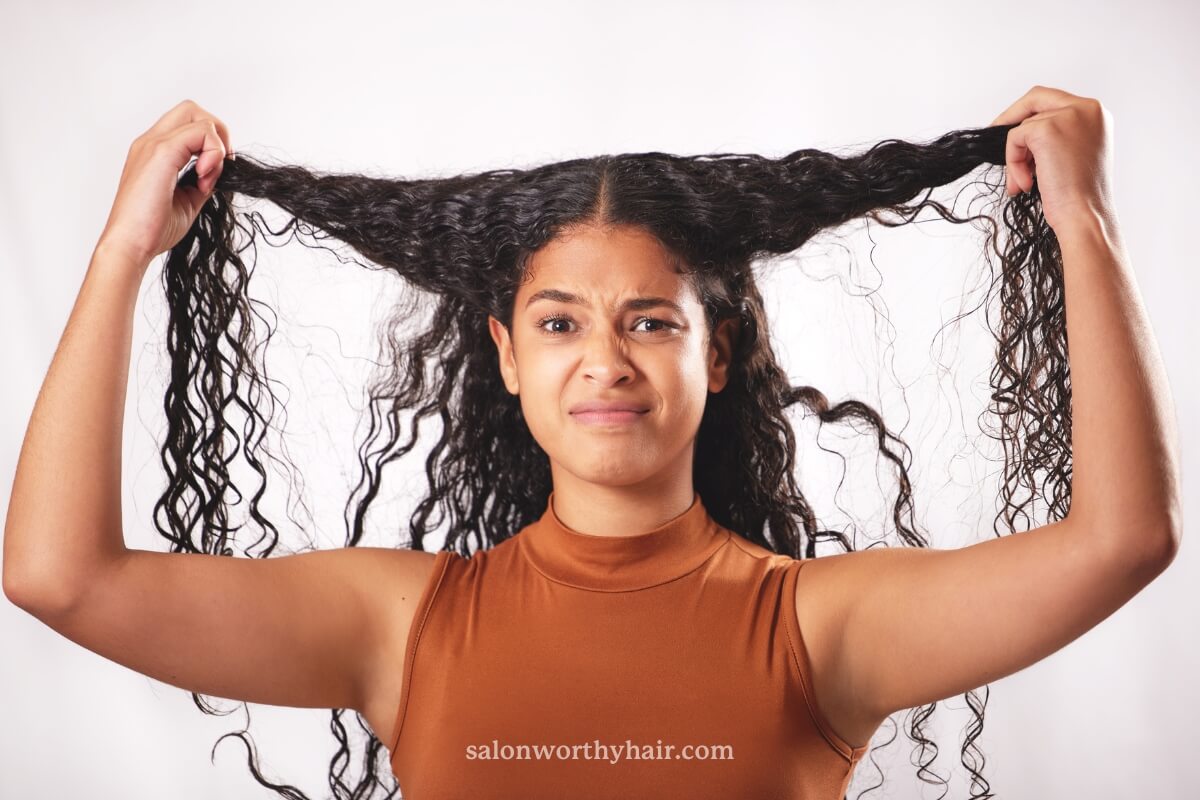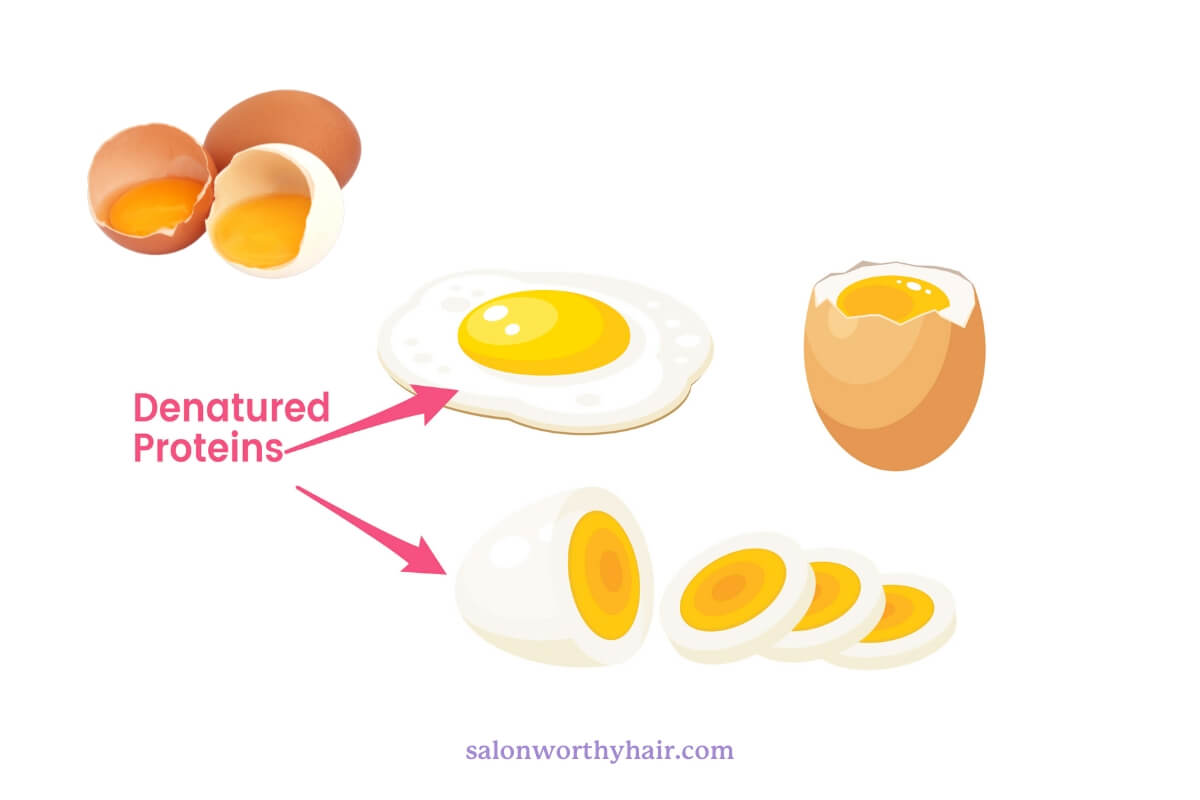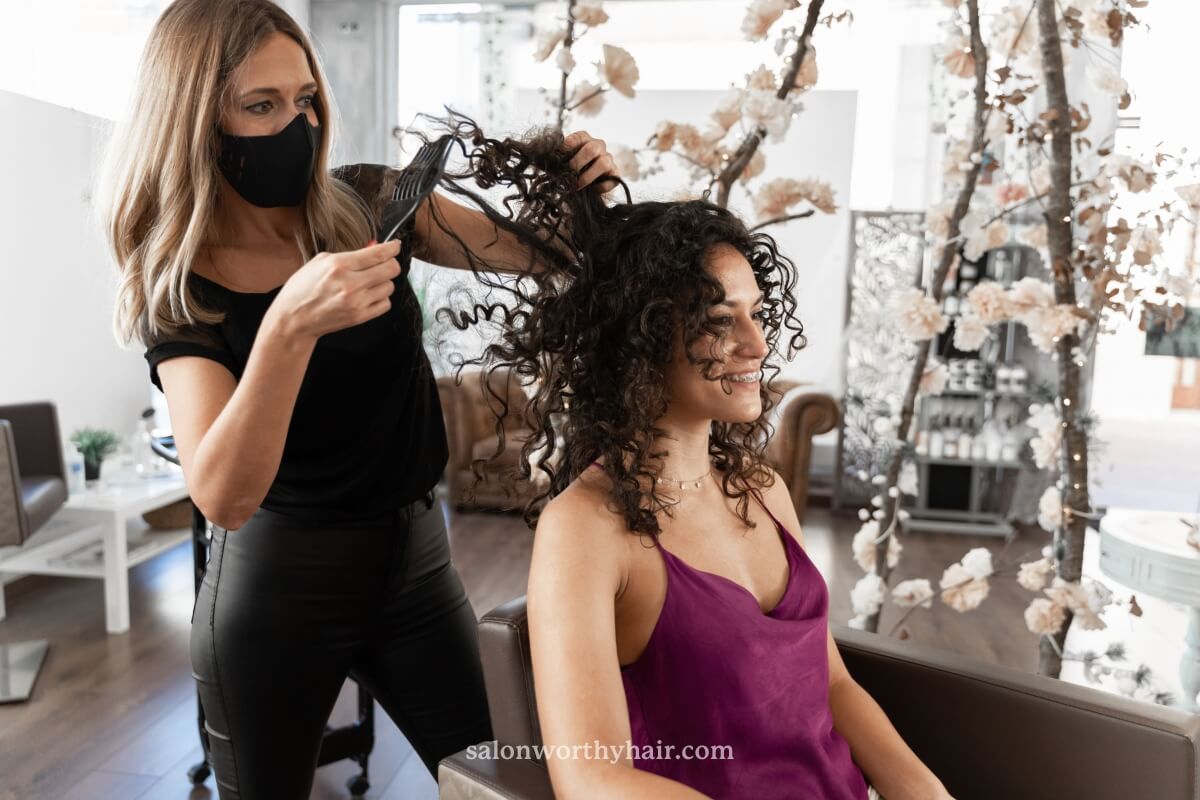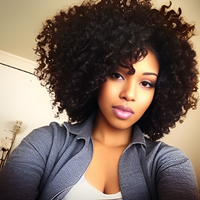How to Repair Heat Damaged Curly Hair – The 3-Step Process
Updated on
This post may contain affiliate links. As an Amazon Associate, we may earn from qualifying purchases.

Heat is a curl killer.
And when your curls take a hit from heat damage, it’s desolating, to say the least.
In my pursuit to stretch my hair from curly to straight with temperatures high enough to roast a chicken, I ended up with severely heat-damaged curls that looked like dry ramen noodles.
Yes, as most misguided teenagers do, I’ve been guilty of straightening my natural hair with intense heat. My hair became so unpredictable that I couldn’t even recognize my true natural curl pattern.
I was having a curl crisis!
- My curls were vanishing.
- My hair felt limp and stringy (loosened curl pattern).
- I had weird curls with straight ends.
- My ends were doing the rice crispy.
- My hair was mixed textures central.
- And it wouldn’t grow past BSL.
This was when I realized my curls were cooked.
I spent months trying to bring my curls back, and after much patience, hair products, tears, and sweat …
I eventually found a way.
But I hate to be the bearer of bad news.
The truth is:
You cannot 100% undo heat damage in your hair.
You can only restore damaged hair to some extent because hair does not have living cells and is considered “dead.” It will not respond and heal in the same way as a living tissue.
But I promise, you will be able to get your natural curls back by following this 3-step process:
- Conceal the damage (Faking your curls).
- Grow out your hair.
- Cut the damaged parts (Curl cutting techniques).
Here’s why this method works:
To repair curly hair that is damaged by heat, you’ve got to understand 4 simple things:
- Curl pattern.
- Denaturation process of the hair.
- How natural hair grows.
- How to cut damaged hair.
Heat damage is a condition where the hair’s protein gets denatured (altered and disrupted).
Imagine an egg, for example. Eggs are complete functional proteins with highly organized structures similar to human hair. Egg proteins organize themselves in a compact form sustained by weak bonds (like curly hair).
Applying heat ruffles the egg-white proteins, breaks the weak bonds (disulfide bonds), and allows the protein glob to unfold and change shape.
This is called Denaturation.
And this is what happens to the proteins in the hair when it’s heat damaged.

Curl pattern refers to the shape and texture of an individual’s hair strands, which is determined by the hair follicle’s shape and the way the hair strand naturally grows out of the scalp.
With this newfound understanding in mind, after reading this article, I guarantee you’ll find that Aha! Moment and thank me later for the tips I am about to reveal.
I’ve gone above and beyond and done much research backed by science and professional hairstylists to show you how to finally get your natural curls back after heat damage.
So let’s get started.
STEP 1: Conceal the Damage
The first step to restoring curly hair from heat damage is to embrace a hair care routine that helps to conceal the damage. Your curls won’t bounce back overnight, so you can’t keep hiding them.

But you can use a few products to revive your curls and disguise the damage.
Let me show you how and what to use:
Get an Olaplex Hair Repair Treatment
Olaplex is a haircare brand that focuses on hair damage repair and prevention products. By understanding the science of hair damage, Olaplex formulates products that get to the root of the problem to restore the hair’s structure and function.
It is one of the best products to restore damaged curls due to its unique and innovative formula that reconnects broken disulfide bonds in the hair.
Olaplex repairs heat-damaged curly hair by targeting and strengthening the s-bonds in the hair’s keratin structure to restore strength and elasticity and protect against future damage.
It is recommended to have the Olaplex treatment done in a hair salon by a professional and experienced hairdresser. They will be able to assess your hair and customize the treatment based on various factors such as porosity, the extent of the damage, and your hair’s unique texture.
Olaplex Hair Repair Treatment
Get a Hair Spa Treatment
A hair spa treatment is a haircare service that provides a comprehensive hair restoration treatment, focusing on nourishment, hydration, and revitalization. The treatment involves a series of steps, such as deep conditioning, scalp massage, and steam therapy.
Here’s how a hair spa treatment can help repair heat damaged curly hair:
- Deep Conditioning: Hair spa treatments begin with deep conditioning, which involves applying a nourishing conditioner or hair mask to the hair. This helps replenish lost moisture and essential nutrients, restoring the hair’s natural elasticity and reducing breakage.
- Scalp Massage: A relaxing scalp massage stimulates blood circulation and promotes a healthier scalp. It encourages the growth of new, healthier hair that is more resistant to heat damage.
- Steam Therapy: Steam therapy opens up the hair cuticles, allowing the deep conditioner or hair mask to penetrate more effectively. This process helps to repair the hair’s internal structure by providing essential nutrients and moisture.
Hair spa treatments can be done at selected hair salons. Check if any salons in your area offer such treatments and book one ASAP. You won’t regret it!
Use a Damage Repair Pre-Wash Treatment
A damage repair pre-wash treatment for hair is a cream designed to be applied to the hair before washing or shampooing. Its primary purpose is to address and repair various types of hair damage and improve the overall health and appearance of the hair.
Pre-wash treatments are formulated with nourishing and restorative ingredients, such as natural oils, proteins, vitamins, and other essential nutrients, that penetrate deep into the hair shaft and repair the hair from within. Applying the treatment before washing helps shield damaged hair from the stripping effects of harsh shampoos and hot water, which can make the hair harder to manage and style.
If you have limp and undefined curls that just feel weighed down by heavy frizz every time you wash, a pre-wash repair treatment might be just what your hair needs. The best part is that these treatments are super easy to use and only take a few minutes to apply before shampooing.
Here’s an excellent product to add to your pre-wash routine:
Nexxus Keraphix Damage Repair Pre-Wash
Heat damage can cause the hair’s internal bonds to weaken, leading to breakage and split ends. Curly hair, in particular, can become dry and stringy after washing when it’s heat damaged. The Nexxus Keraphix damage repair pre-wash treatment helps to fortify these bonds, increasing the hair’s resilience and reducing the risk of further damage. It also hydrates and nourishes the hair, improving its moisture retention.
It makes curly hair easier to style and maintain, reducing the need for additional heat-styling tools, like hair straighteners and blow dryers, and minimizing the risk of future damage.
Additional Tip:
When washing your hair after the pre-wash, use a moisturizing shampoo designed for damaged hair and avoid using a rough towel and blow dryer to dry your curls. Use a microfiber towel to gently blot moisture out of your fragile strands, and wrap your head with the towel to protect your wet curls. Once the towel has soaked up all the excess water, unwrap your hair, allow it to air dry, and use styling products (if needed) while it is still damp.Use a Curl Rehab Treatment
A curl rehab (restoration) product is a specialized hair treatment designed to restore, nourish, and rejuvenate heat damaged curly hair.
Curl rehab products are formulated with a blend of natural oils, proteins, and moisturizing agents that work together to address the unique needs of curly hair, especially when it has been damaged by heat.
Benefits of curl restoration treatments for heat damaged curls:
- Moisture Restoration: Heat-damaged curly hair tends to be dry, stringy, and brittle due to moisture loss. A curl-restoring treatment contains hydrating ingredients, such as aloe vera, glycerin, and natural oils, that help to replenish the hair’s moisture levels and improve its elasticity.
- Protein Replenishment: Heat damage can also cause the hair’s protein structure to become compromised. Curl rehab products often include hydrolyzed proteins, such as keratin or silk, that help to rebuild the hair’s structure and strengthen the individual strands.
- Curl Definition: Damaged curls often lose their natural shape and definition. Curl rehab products contain ingredients that help to enhance the hair’s natural curl pattern, making it more defined and easier to style. This can include humectants, such as honey or propylene glycol, that attract moisture and encourage the formation of natural curls.
- Damage Repair: With a blend of ingredients that target and repair damaged areas of the hair, such as split ends or weak spots, the treatment penetrates the hair shaft and helps to repair the cuticle and cortex layers.
Here are 2 of the best curl rehab treatments to consider:
Curlsmisth Bond Curl Rehab Salve
Olaplex No. 7 Bonding Oil
Use A Restorative Hair Mask
A restorative hair mask is an intensive, deep-conditioning treatment designed to heal and revitalize heat damaged hair. Enriched with potent ingredients, it delivers targeted nourishment, restore vitality, and impart a healthy appearance.
Imagine the restorative hair mask as a skilled hair surgeon, meticulously repairing each strand with bioactive peptides and hydrolyzed proteins. These “hair doctors” target weak spots and rebuild the hair’s internal structure to strengthen every curl.
Besides healing the hair to conceal the damaged parts, a restorative mask also delivers curl-enhancing magic, time-release hydration, hair resurrection, and thermal protection to prevent future damage.
Here are the best restorative hair masks to consider:
K18 Leave-In Molecular Hair Repair
Briogeo Don't Despair Repair Mask
SheaMoisture Intensive Manuka Honey Hair Masque
tgin Miracle RepaiRx Curl Protein Reconstructor
Try a Hot Oil Treatment for Damaged Hair
A hot oil treatment involves applying warm oil to the hair and scalp and then covering the head with a shower cap or towel to trap heat and allow the oil to seep into the hair shaft.
Here are the benefits of hot oiling damaged hair:
- Penetration and Absorption:Heat improves the oil’s viscosity and increases its ability to penetrate and effectively deliver nutrients and moisture to the hair’s inner cortex. The warm oil molecules have increased kinetic energy, allowing them to easily pass through the hair cuticle.
- Cuticle Realignment:The hair shaft comprises several layers, including the cuticle, consisting of overlapping cells protecting the inner layers. Heat damage can cause these cells to become raised and disorganized, leading to frizz, tangling, and a dull appearance. The oil’s warmth helps soften the cuticle, allowing it to relax and realign, thereby reducing frizz and increasing shine.
- Hydro-Lipid Balance:A hot oil treatment helps to restore the hydro-lipid balance by supplementing the hair’s natural oils, leading to increased hydration and improved elasticity. This is particularly beneficial for curly hair, which is naturally more susceptible to dryness due to its spiral structure, making it difficult for the scalp’s natural oils to travel down the hair shaft.
- Oxidative Stress Reduction:Heat damage can cause the production of Reactive Oxygen Species (ROS) in the hair, which are molecules that trigger oxidative stress, further damaging the hair structure. Many natural oils used in hot oil treatments, such as coconut and argan oil, contain antioxidants that can neutralize ROS, reducing oxidative stress and promoting healthier hair.
- Protein Boost:Heat damage can lead to the loss of essential proteins in the hair, such as keratin, responsible for the hair’s strength and elasticity. Some oils, like coconut oil, have been shown to reduce protein loss when applied to hair. A hot oil treatment can help protect and preserve these proteins, improving the hair’s overall health and resilience.
Here are the best oil treatments to consider for dry and damaged curly hair:
Vo5 Hot Oil Treatment
Mielle Organics Mint Almond Oil
STEP 2: Grow Your Hair Out

Growing your hair out in low-maintenance protective hairstyles is a strategic approach to dealing with heat-damaged curly hair without cutting off a lot of lengths.
A protective hairstyle protects your ends to minimize and reduce breakage. It lets you coddle and slowly slip your damaged ends while playing to your hair’s strengths.
Most important of all:
A protective hairstyle encourages length retention and allows your natural hair to grow.
Just tuck it away and let your follicles do the work.
Once I stopped playing with my hair, I noticed more growth and less shedding. I started to see more length retention.
Protective hairstyles are a curly-haired girl’s best friend for recovering from heat damage.
Here are the benefits of protective hairstyles for heat damaged curly hair:
- Allows you to go low-maintenance.
- Saves you time on daily styling.
- Allows you to forget about your hair and let it be.
- Helps your hair retain length until you cut off the damage.
- Allows you to transition back to your natural hair smoothly.
- Masks all the different textures that drive you crazy.
- Gives your hair uniformity.
- Helps you wash your hair less.
- Injects a new vibe into your overall look.
- Reduces the need for mechanical damage from combing styling etc.
- Helps make your natural curls tighter and neat.
Here are some of the most popular protective styles that are gentle and low maintenance for damaged curly hair:
Twisted Buns
The twisted buns hairstyle for curly hair is a protective style that involves creating two or more twisted buns or knots on the head using the hair’s natural curls. Twisted buns require minimal manipulation once set, reducing the risk of breakage and promoting hair growth. Less handling means less stress on the hair strands, allowing them to grow and remain healthy.
To create a twisted buns hairstyle for curly hair, follow these steps:
- Start with clean, detangled, and moisturized hair.
- Apply a leave-in conditioner or hair oil to ensure your hair is well-hydrated.
- Part your hair in your desired style, such as a middle or side part.
- You can create two or more sections depending on the number of buns you want.
- For each section, twist the hair from the roots to the ends, keeping the tension consistent to form a smooth, neat twist.
- Once each section is twisted, coil the twist around itself to create a bun.
- Secure each bun with a hairpin or a hair tie.
- Finish the style by applying a light-hold hair gel or spray to keep the buns in place and to smooth down any flyaways.
The Mini Twists
The Mini Twists hairstyle involves creating numerous small, two-strand twists all over the head using the hair’s natural curls. Keeping your hair in mini twists for an extended period minimizes the daily styling stress and manipulation.
Here are the benefits:
- Lasts for 3 – 6 weeks.
- Prevents hair from getting frizzy.
- More versatility with styling.
- Gives your hair a uniform look.
To create mini twists for curly hair, follow these steps:
- Begin with clean, detangled, and moisturized hair.
- Apply a leave-in conditioner or hair oil to ensure your hair is well-hydrated.
- Divide your hair into small sections.
- The size of the sections will determine the size of your mini twists.
- For each section, separate the hair into two equal parts and twist them around each other from the roots to the ends, maintaining consistent tension to form a smooth twist.
- Continue this process, working through all the sections on your head until your entire head is covered in mini twists.
- To finish the style, apply a light-hold hair gel or spray to secure the twists and keep them in place. You can also use hair oil or serum to add shine and reduce frizz.
Whichever one you choose, you must take care of your protective hairstyle to prevent it from accumulating dirt and loosening.
Tips for protective hairstyles:
- Keep it moisturized.
- Keep it clean. Dirt, grease, and products will build up.
- Don’t leave it for too long.
- Let your hair dry overnight when you wash.
- Sleep on a satin/silk pillowcase to keep it in lock.
Use the right products to keep your locks neat, tidy, tight, and long-lasting.
My favorite product when I’m sporting locks is Dollylocks.
STEP 3: Cut the Damaged Parts After They’ve Grown Out
The next stage after growing your curly hair out is the big chop.

This is where most people get it wrong.
They choose a traditional hairstylist who has no idea how curly hair works.
“The biggest mistake I see people making when cutting curly hair is approaching it as if it’s the same as all the other hair patterns they are used to cutting.” – Says Terry Whiddon, ColorProof Evolved Color Care Platform Artist.
Traditionally, all trimming techniques are designed for straight hair.
Your stylist will wet, stretch, or even straighten your hair before cutting.
Big mistake.
This is why you end up with uneven, chopped-up, and unnatural cuts that make you look like a 4-year-old with a Christmas tree on top of your head.
Cutting naturally curly hair is not the same as cutting straight hair.
It’s like sculpting:
- 40% art.
- 40% science.
- And 20% talent.
No wonder why hairdressers charge more to cut afro hair.
Only a proper curly hair stylist (curl professional) understands:
- Curl speak.
- How to cut curly hair with deep graduated layers.
- The natural shrinkage of your hair.
- The direction your curl moves.
- Natural hair with no curl pattern.
- How much spring your hair has when it’s dry.
- And your hair’s growth pattern.
So beware of hairstylists that straighten or wet your hair first before cutting. Because wet or stretched hair looks longer. So there’s the illusion that more has to be cut.
The result?
When your hair dries, it shrinks unevenly and unpredictably with holes and choppy layers. Oouch!!
A curly haircut is more about making each curl look its best. Not just a way to trim off damaged ends.
It’s all about SHAPE – A nicely de-bulked sculpted mane that allows your curls to fall back into their natural shape.
Let me show you the 2 best techniques you can adopt for cutting off heat damaged natural hair:
DevaCut Haircut

The DevaCut is a specialized haircut technique designed specifically for curly hair. It was developed by Lorraine Massey, the co-founder of Devachan Salon and the DevaCurl brand. The DevaCut method aims to enhance curly hair’s natural texture and shape, making it easier to manage and maintain.
The DevaCut Explained:
- Dry cutting:
- Unlike traditional haircuts, which are usually performed on wet hair, the DevaCut is done on dry hair. This allows the stylist to see the hair’s natural curl pattern and shape, ensuring that each curl is cut to optimize its spring and bounce.
- Curl by curl cutting:
- The DevaCut focuses on cutting individual curls rather than cutting the hair in sections. This approach helps maintain the hair’s natural shape, ensuring that each curl falls correctly and maintains its definition.
- Customization:
- A DevaCut is tailored to suit each individual’s unique curl pattern, texture, and needs. When determining the best cut and style, the stylist considers factors such as face shape, hair volume and density, and curl type.
A DevaCut trims away split ends and damaged hair caused by heat-styling tools or chemical treatments. Removing these damaged areas prevents further damage from spreading up the hair shaft and allows the hair to regain its natural curl pattern.
This haircut focuses on enhancing the natural texture of curly hair, reducing the need for heat-styling tools such as curling irons. It makes curly hair more manageable and easier to style with a good curl definition.
Having such a haircut also provides an opportunity for the stylist to recommend specific products and care routines to help you prevent future heat damage to your curls.
Watch how YouTuber Afia Asantewaa’s Type 4 Afro gets a gorgeous, sculpted shape within a matter of minutes.

Ouidad Carve & Slice Haircut

The Ouidad Carve & Slice haircut is a specialized technique designed specifically for curly hair, created by Ouidad, the founder of the Ouidad brand and salon. The Carve & Slice technique involves carving out sections of the hair to remove bulk and create a defined curl pattern. This is done by carefully cutting the hair at precise angles to encourage curls to fit together seamlessly.
The stylist thins out sections of hair to create a balanced shape and volume throughout the head. This helps to reduce the pyramid effect often seen in curly haircuts and to create a more cohesive curl pattern.
An Ouidad Carve & Slice haircut can help trim the damaged hair caused by heat-styling tools and create a balanced shape and volume throughout the head.
The stylist takes into consideration factors such as face shape, hair density, and curl type when determining the best cut and style.

Now It’s Your Turn to Reclaim Your Curls
There is no overnight miracle cure to repair heat damaged curly hair.
It is a process, and you have to be willing to put in the work to revive your curls.
This process will help you embark on a journey of self-love and show you how to bring out your natural curls again, no matter how bad the heat damage is.
It’s all about being patient and doing the right thing.
About the Author
 Kayla Davis
Kayla DavisKayla Davis is a self-proclaimed skincare and haircare junkie who loves testing out new products and writing about her experiences. Her bathroom shelves are always overflowing with beauty products. You name it - it's there.









